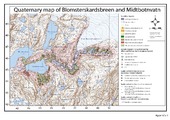Glacier fluctuations and sediment transport at Vestre Blomsterskardsbreen, Folgefonna
Master thesis
Permanent lenke
https://hdl.handle.net/1956/4423Utgivelsesdato
2010-05-18Metadata
Vis full innførselSamlinger
- Department of Geography [676]
Sammendrag
Vestre Blomsterskardsbreen is the southernmost glacier outlet of southern Folgefonna, a maritime temperate plateau glacier located on the Folgefonna peninsula in western Norway. It drains into Lake Midtbotnvatn, which is located approximately 5 km from the present glacier terminus.Vestre Blomsterskardsbreen is an adequate area to reconstruct glacier fluctuations based on interpretation of proglacial sediments. A limiting factor is the fact that Lake Midtbotnvatn is regulated for the development of hydroelectrical power since AD 1953, which enlarged the sedimentation rate many times over normal and hence prevents any interpretation of the sediment with respect to glacial activity since then. A continuous record of the relative glacial activity of the glacier outlet has been compiled for the time period AD 1953 to 4235 cal. years BP, based on the DBD record of proglacial sediments and according radiocarbon datings. The reliability of the results was limited by the greatly disturbed sediment structure of the core.Proglacial sediment studies revealed that Vestre Blomsterskardsbreen has been present in the catchment at least during the past 4235 cal. years BP, with remarkable peaks in relative glacial activity around 4200, 2650, 2150, 1800, 1600, 1100 and 140 cal. years BP. Lichen-dated marginal moraines indicate, that the Little Ice Age (LIA) maximum advance occurred during the first half of the 18th century. The latest LIA glacier expansion was dated to AD 1945. The relative glacial activity record of Vestre Blomsterskardsbreen was linked to natural climate archives. As a result, the glacier outlet is considered an indicator for winter climate variability, the winter NAO index and the strengths of the westerlies at the west coast of Norway. Furthermore the glacial record was compared to several selected glacier sites in the Northern Hemisphere; four common glacier advances correspond to the overall relative glacial activity pattern of Vestre Blomsterskardsbreen.
Utgiver
The University of BergenOpphavsrett
The authorCopyright the author. All rights reserved
